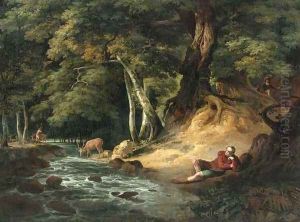William and Romney, George Hodges Paintings
George Romney was an English portrait painter who is remembered as one of the most fashionable artists of his day, rivaling even Sir Joshua Reynolds in popularity for a time. Born on December 26, 1734, in Dalton-in-Furness, Lancashire, Romney was largely self-taught in his early years, showing a natural talent for art that would see him rise to prominence in the late 18th century. His early work included landscapes and historical scenes, but it was his portraits that would define his legacy.
Romney moved to London in 1762, where he studied under portraitist Christopher Steele. His talent quickly became apparent, and by the 1770s, he had established himself as a leading portraitist in the city. He was known for his ability to capture the grace and elegance of his subjects, often employing a soft, refined style that appealed to the sensibilities of his era. Despite his success, Romney never sought membership in the Royal Academy of Arts, an institution led by his rival, Reynolds, which was the center of the British art world at the time.
One of Romney's most famous sitters was Emma Hamilton, best known as the mistress of Admiral Horatio Nelson. Emma became Romney's muse, and he painted her in a variety of guises, from a bacchante to Joan of Arc. These paintings are among his most celebrated works, showcasing his skill in capturing both the physical beauty and the complex personalities of his subjects.
Despite his success, Romney's later years were marked by a decline in health and a retreat from the public eye. He returned to his native Lancashire in 1799, where he lived until his death on November 15, 1802. Though his reputation was overshadowed in the 19th century by the likes of Reynolds and Thomas Gainsborough, modern scholarship has reevaluated Romney's contribution to British art, recognizing him as a master portraitist whose work provides a vivid window into the society and culture of his time.
